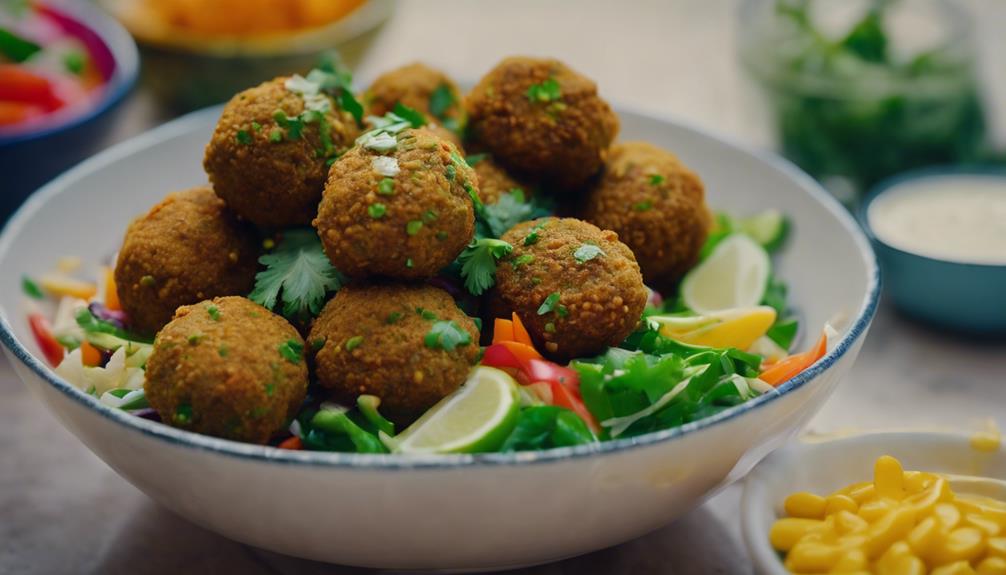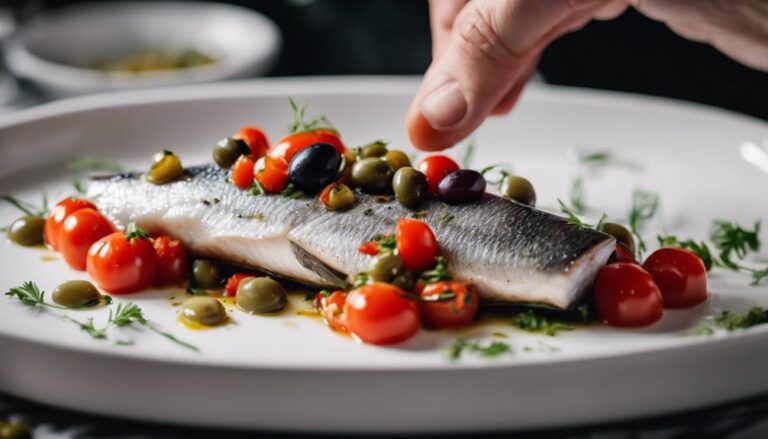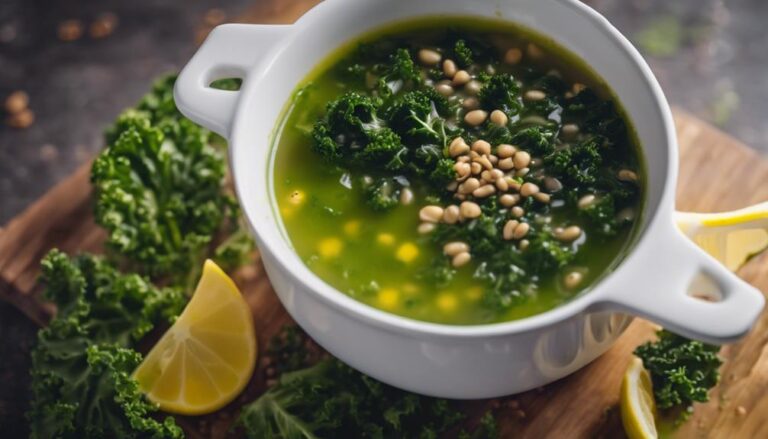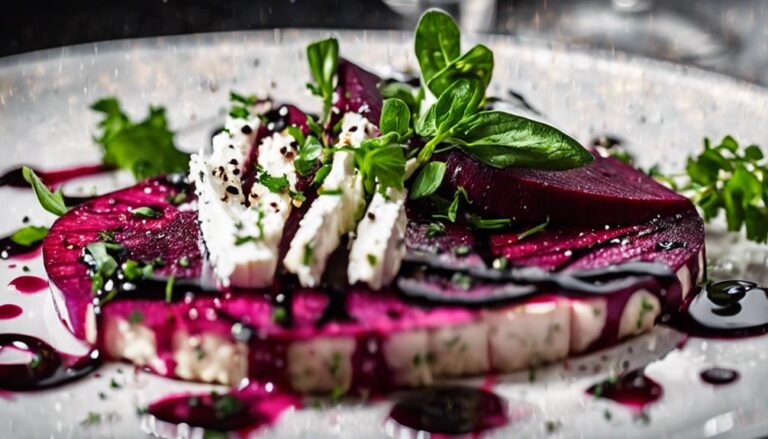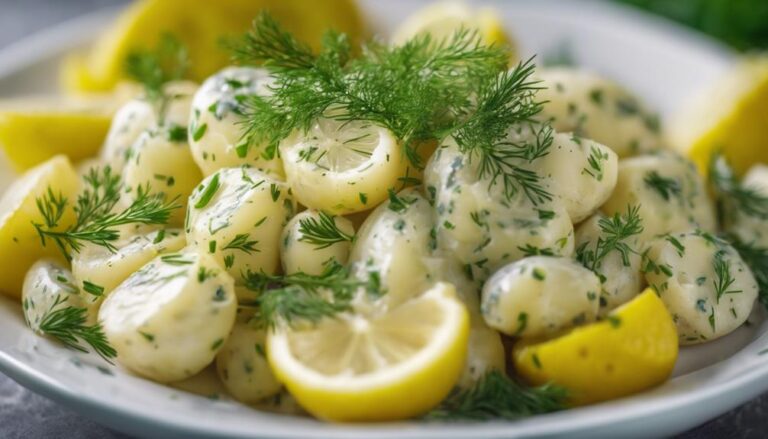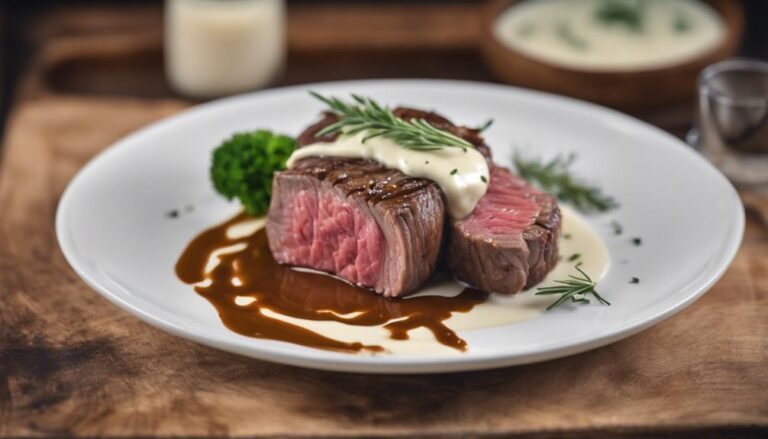Sous Vide Falafel Bowls With Tahini Drizzle
Immerse yourself in the tantalizing world of Sous Vide Falafel Bowls with Tahini Drizzle. Enjoy perfectly cooked falafel with a tender, moist texture thanks to sous vide cooking. The tahini drizzle adds a burst of flavor, exciting your taste buds with a modern twist that complements the savory falafel. Find out how this innovative dish elevates the traditional falafel experience and offers a delightful contrast you won't want to miss.
What You Will Learn Here
- Sous vide cooking ensures moist, tender falafel
- Tahini drizzle enhances flavor profile
- Innovative twist on traditional falafel
- Modern culinary experience with sous vide method
- Contrasting textures and flavors in falafel bowls
Falafel's Middle Eastern Origins
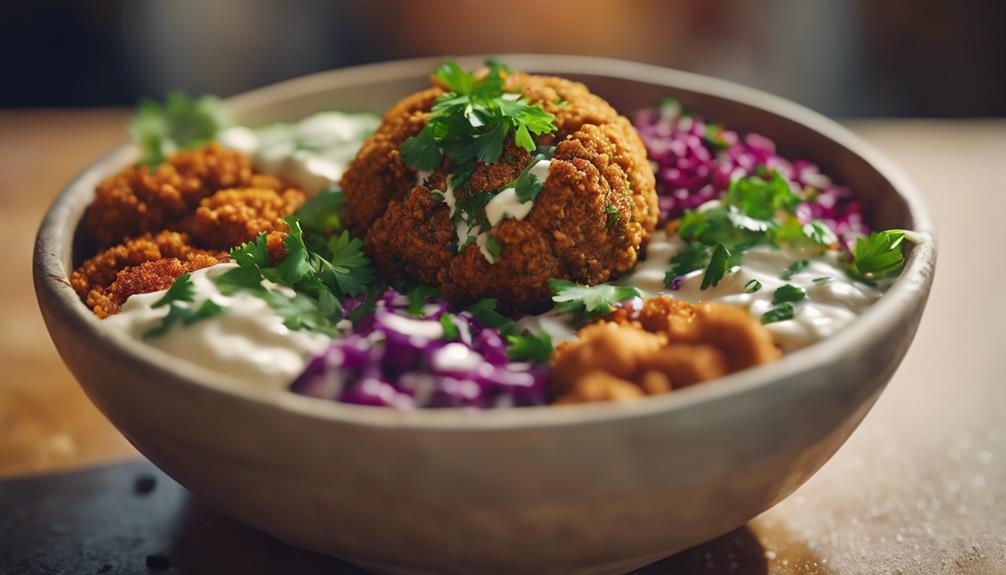
Falafel holds a rich cultural history, with its debated origins spanning Egypt, Lebanon, and Palestine. The ingredients in falafel, typically ground chickpeas or fava beans mixed with herbs and spices, reflect the region's agricultural abundance.
Cooking techniques play an important role in achieving the coveted crispy exterior and flavorful interior of falafel.
Falafels Cultural History
Having originated in Egypt and later spreading throughout the Middle East, falafel has a rich cultural history deeply intertwined with the region's culinary traditions.
In its early days, falafel was crafted from fava beans, but as it journeyed across the Middle East, chickpeas became the preferred base, particularly in Lebanon and Israel.
This delectable dish, often served in a pita alongside fresh vegetables and drizzled with creamy tahini sauce, has become a beloved street food staple in various Middle Eastern countries.
The name 'falafel' itself, originating from the Arabic word 'filfil' meaning pepper, reflects the traditional use of ground pepper in its preparation.
Over centuries, falafel has established itself as a flavorful and nourishing vegetarian delight deeply cherished in Middle Eastern cuisine.
Ingredients in Falafel
Originating in Egypt and later adopted across the Middle East, the traditional ingredients in falafel reflect the diverse culinary heritage of the region. The falafel mixture typically consists of ground chickpeas or fava beans blended with a variety of herbs and spices, such as parsley, cilantro, garlic, and cumin. These ingredients give falafel its distinctive flavor profile and aromatic appeal.
In Levantine cuisine, chickpeas are commonly used, while in Egypt, fava beans were historically the base. The chickpea mixture is carefully seasoned and shaped into small patties before being fried to perfection, resulting in a crispy exterior and a moist, flavorful interior.
When served, falafel is often accompanied by a tangy green tahini sauce, enhancing its taste with a creamy and nutty finish.
Falafel Cooking Techniques
In Middle Eastern culinary traditions, the process of preparing falafel involves intricate cooking techniques that ensure a perfect balance of flavors and textures. To create falafel, a mixture of ground chickpeas or fava beans, herbs, and spices is carefully blended to form a cohesive dough-like consistency.
The mixture is then shaped into small balls or patties, an essential step for ensuring even cooking and a crispy exterior. Traditionally, falafel is deep-fried to achieve a crunchy outside while maintaining a moist and flavorful interior.
The falafel balls or patties are often served in a bowl with salad and a generous drizzle of creamy tahini sauce, enhancing the dish with its nutty and tangy flavors, completing the culinary experience.
Chickpeas and Fresh Herbs

Blending chickpeas and fresh herbs together creates a flavorful and aromatic falafel mixture, essential for achieving the unique texture and taste of this Middle Eastern dish. When using a food processor to combine these ingredients, you guarantee a well-mixed and cohesive falafel mixture that forms the foundation for delicious falafel balls. Here's why this combination is vital:
- Nutritional Benefits: Chickpeas are rich in plant-based protein and fiber, making them a nutritious choice for falafel. The addition of fresh herbs like parsley and cilantro not only enhances the flavor but also provides a nutritional boost.
- Flavor Enhancement: Fresh herbs bring vibrant flavors and freshness to the falafel mixture, elevating the overall taste experience. The combination of chickpeas and herbs creates a harmonious blend of savory and herbaceous notes in every falafel ball.
- Aromatic Profile: The aroma that emanates from the blend of chickpeas and fresh herbs is enticing and adds to the sensory experience of enjoying falafel. It's the aromatic profile that sets falafel apart and delights the senses.
- Texture and Taste Fusion: The unique texture and taste of falafel come from the perfect fusion of chickpeas and fresh herbs. This combination results in a satisfying mouthfeel and a burst of flavors with every bite.
Top-Rated Falafel Variations
Looking to expand your falafel horizons? Consider trying out some top-rated variations like crispy baked falafel balls, baked falafel pita pockets, and a flavorful herbed falafel burger recipe.
These options offer unique textures and flavors that are sure to delight your taste buds and add a new twist to your falafel experience.
With crispy exteriors and tender interiors, these falafel variations are favorites among many for their delicious and innovative take on the classic dish.
Crispy Baked Falafel Balls
For those seeking a lighter and healthier twist on traditional falafels, consider trying out crispy baked falafel balls as a flavorful alternative. Here are some reasons why baking falafel balls can be a great choice:
- Healthier Option: Baking falafel balls reduces excess oil and calories, making them a healthier alternative to fried falafels.
- Crispy Texture: Despite being baked, falafel balls can maintain a crispy exterior, providing a satisfying crunch.
- Even Cooking: Baking results in a more uniform and evenly cooked falafel, ensuring a consistent texture throughout.
- Convenient: Baked falafel balls are easy to make, ideal for meal prep, and can be stored for later use, offering convenience and flexibility in meal planning.
Baked Falafel Pita Pockets
To elevate your falafel experience, consider indulging in the delectable crunch and savory goodness of Baked Falafel Pita Pockets, a top-rated variation that promises a healthier and equally satisfying alternative to traditional fried falafels. When you bite into these baked falafel pita pockets, you'll experience a delightful contrast between the crispy exterior and the tender interior, creating a perfect harmony of textures.
Here are some reasons why you should try this falafel variation:
- Baked falafel pita pockets offer a healthier twist on traditional fried falafels.
- These falafel pockets are filled with a flavorful mix of chickpeas, herbs, and spices.
- Baking the falafels results in a crispy exterior and a tender interior.
- Pita pockets provide a convenient and portable way to enjoy falafels on the go.
Herbed Falafel Burger Recipe
Elevate your falafel game with the tantalizing flavors and vibrant colors of our Herbed Falafel Burger Recipe, a top-rated variation that infuses fresh herbs to create a fragrant and herbaceous twist on the classic falafel experience. Here's why you'll love this herb-infused falafel option:
- Freshness: The addition of parsley and other herbs brings a burst of freshness to every bite.
- Colorful Presentation: The vibrant green hue from the herbs adds visual appeal to your falafel burgers.
- Enhanced Flavor: The combination of grated carrot and parsley creates a delightful flavor profile that complements the nuttiness of the chickpeas.
- Perfect Pairing: Drizzle with creamy tahini sauce for a delectable finish that ties all the flavors together harmoniously.
Falafel Frying Temperature Tip
When frying falafel, it's essential to maintain the oil temperature between 350-375°F for a crispy exterior and fully cooked interior. Consistent oil temperature helps prevent falafel from becoming greasy.
Testing the temperature with a small falafel ball is a convenient way to confirm readiness before frying a batch.
Optimal Frying Temperature
For best results when frying falafel, make sure that the oil temperature stays between 350-375°F (175-190°C) to achieve a crispy exterior and a thoroughly cooked interior. Frying falafel in olive oil at this ideal temperature range guarantees that the exterior turns a beautiful golden brown while the inside cooks to perfection.
It's crucial to maintain a medium heat throughout the frying process to prevent the falafel from becoming greasy or burnt. Using a deep-fry thermometer can help you accurately monitor the oil temperature, allowing you to make any necessary adjustments to keep it within the perfect range.
Crispy Falafel Texture
To achieve the perfect crispy texture in your falafel, maintaining the oil temperature between 350-375°F is crucial for a golden-brown exterior and a moist, well-cooked interior. Frying falafel at the correct temperature guarantees that they absorb minimal oil while developing a delicious crunch.
If the oil is too cold, the falafel will become greasy and soggy; on the other hand, if it's too hot, the outside may burn before the inside cooks through. Consistency in oil temperature throughout frying is vital to achieving a uniform, crispy texture in every bite.
Using a deep-fry thermometer can help you monitor and adjust the temperature accurately. The result should be delicious falafel with a crunchy, golden-brown crust that encases a flavorful and moist interior.
Cooking Time Recommendations
Consider utilizing a kitchen timer or smartphone app to maintain consistent oil temperature at 350-375°F for best falafel frying results. This temperature range guarantees a crispy exterior while keeping the interior moist.
To monitor accurately, use a candy or deep-fry thermometer. Sudden fluctuations can impact texture and cooking time, leading to unevenly cooked falafel.
To achieve perfectly golden-brown falafel balls, consistency in oil temperature is essential. When forming the falafel mixture into balls, wet hands help prevent sticking and create smooth surfaces.
Once fried to perfection, drizzle with tahini sauce in a large bowl for a delicious falafel bowl experience. Mastering the frying temperature will elevate your falafel game to new heights.
Final Thoughts
In contemplating the Sous Vide Falafel Bowls with Tahini Drizzle, it becomes clear that this innovative dish truly enhances the traditional falafel experience to new heights.
The combination of a falafel bowl prepared through the sous vide method and topped with a luscious tahini drizzle offers a modern twist that excites the palate.
The sous vide cooking technique guarantees that the falafel balls are perfectly cooked, resulting in a tender and moist texture that distinguishes this dish.
The addition of the tahini drizzle brings a creamy and nutty element that enhances the overall flavor profile, providing a delightful contrast to the savory falafel.
Frequently Asked Questions
Can I Use Canned Chickpeas Instead of Dried Chickpeas for Making Falafel?
Yes, you can use canned chickpeas instead of dried chickpeas for falafel. While canned chickpeas are convenient, they may result in a slightly softer texture. Drain well and pat dry to minimize excess moisture for better crisping during cooking.
How Long Does Tahini Sauce Last in the Refrigerator?
When storing tahini in the fridge, guarantee proper sealing to prolong its shelf life. Tahini can last up to six months refrigerated. Keeping it tightly covered and away from moisture and light helps maintain its freshness.
Can I Freeze Falafel for Later Use?
Yes, you can freeze falafel for later use! Storing in airtight containers or freezer bags preserves texture. Reheat in the oven for a crispy exterior. Falafel's flavor shines in freezer-friendly recipes like wraps or salads.
Are There Any Gluten-Free Alternatives to Breadcrumbs for Coating the Falafel?
For a gluten-free falafel coating, try using almond flour, quinoa flakes, rice flour, cornmeal, potato flakes, or rolled oats instead of breadcrumbs. These alternatives offer a variety of textures and flavors to enhance your falafel experience.
Can I Substitute the Fresh Herbs in the Falafel Mixture With Dried Herbs?
Yes, you can substitute fresh herbs with dried in the falafel mixture. Dried herbs offer a more intense flavor profile and are suitable for baking or frying. However, they may result in slightly different texture differences, so adjust accordingly.
Conclusion
Indulge in the rich flavors and textures of sous vide falafel bowls with tahini drizzle.
The tender chickpea patties, bursting with fresh herbs and spices, are sure to satisfy your taste buds.
Experiment with different falafel variations to find your favorite combination.
Remember, the key to perfect falafel is maintaining the right frying temperature.
Enjoy this delicious Middle Eastern dish as a wholesome and satisfying meal.
